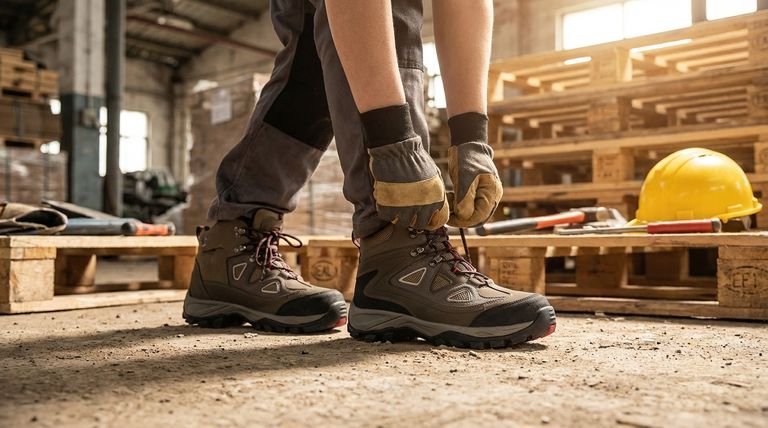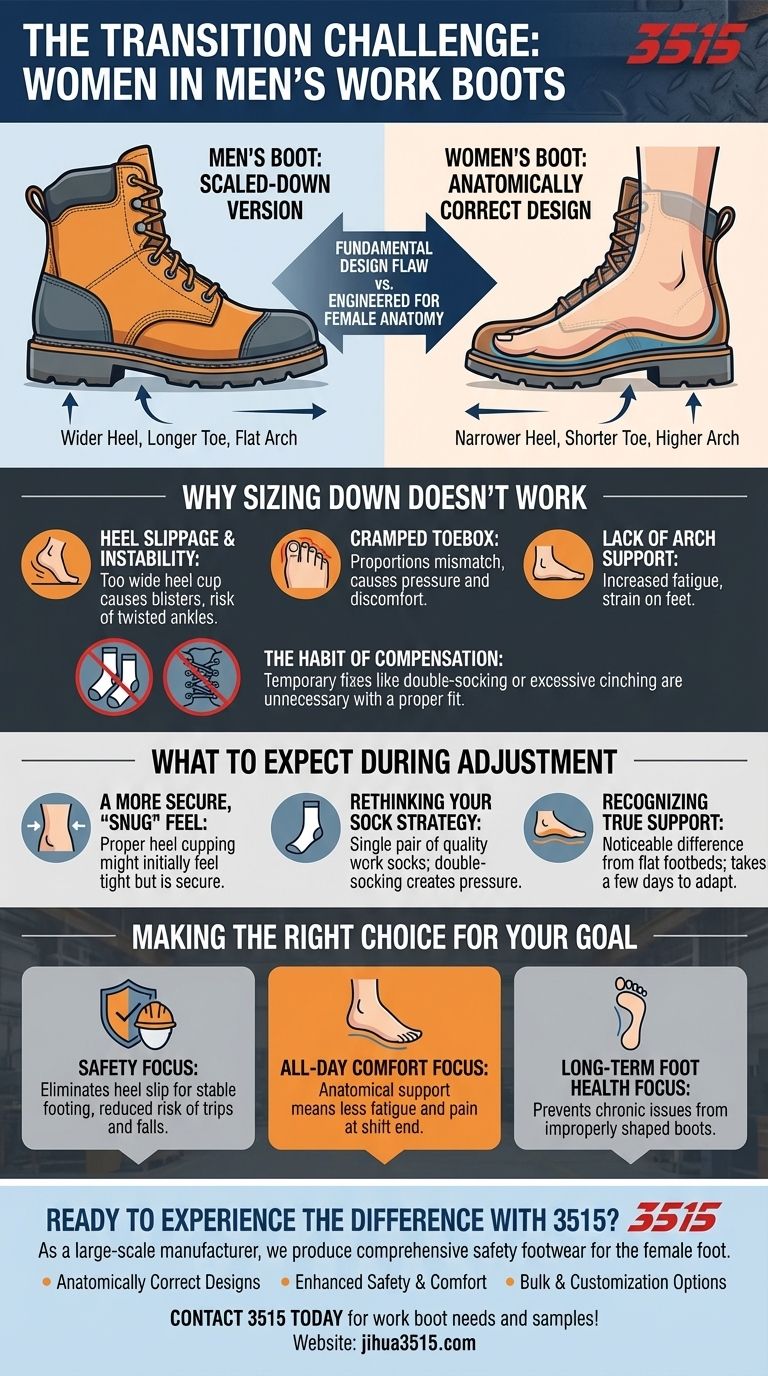The primary challenge is one of adjustment. When transitioning from men's to women's work boots, women must adapt to a fundamentally different fit that is anatomically correct for their feet. This often means breaking old habits, like wearing multiple pairs of socks, that were developed to compensate for the poor fit of a man's boot.
The core issue is that men's and women's feet are not just different in size, but in shape. The challenges of transitioning arise from moving away from a boot that is simply a scaled-down version of a man's to one that is properly engineered for the female foot's distinct anatomy.

Why a Men's Boot Isn't Just a Larger Women's Boot
Many assume work boot fit is only about length and width, but the structural differences are far more significant. This misunderstanding is the source of most fit-related problems.
The Anatomical Mismatch
A true women's work boot is built on a different last—the 3D model a boot is constructed around. This accounts for key anatomical distinctions.
Specifically, women's feet typically have narrower heels in proportion to the forefoot, a shorter toe length, and higher arches.
The Problem with "Sizing Down"
Simply choosing a smaller size in a men's boot fails to address these proportional differences. This mismatch can cause heel slippage, a cramped toebox, or a lack of crucial arch support.
This incorrect fit is not just uncomfortable; it's a safety hazard that can lead to blisters, fatigue, and an increased risk of slips or twisted ankles.
The Habit of Compensation
To make oversized men's boots "work," many women resort to workarounds like doubling up on socks or cinching the laces excessively.
These are temporary fixes for a fundamental design flaw. A properly fitted women's boot makes these compensations unnecessary and even uncomfortable.
What to Expect During the Adjustment Period
Switching to an anatomically correct boot will feel different. Understanding what to expect can make the transition smoother.
A More Secure, "Snug" Feel
A boot designed for a narrower heel will cup the back of your foot securely. For someone accustomed to a loose fit, this proper security might initially be mistaken for being "too tight."
Rethinking Your Sock Strategy
The habit of wearing two pairs of socks must be unlearned. A correctly sized women's boot is designed to be worn with a single pair of quality work socks. Doubling up will create pressure points and friction.
Recognizing True Support
A boot with appropriate arch support will feel noticeably different from the typically flatter footbed of a men's boot. This is a positive change that reduces strain, but it can take a few days for your foot to adapt to the new support.
Making the Right Choice for Your Goal
Navigating this transition is about understanding how a proper fit serves your specific needs on the job.
- If your primary focus is safety: A boot that fits correctly eliminates heel slip and provides stable footing, dramatically reducing the risk of trips, falls, and ankle injuries.
- If your primary focus is all-day comfort: Anatomical support for your arch and heel directly translates to less foot fatigue and pain at the end of a long shift.
- If your primary focus is long-term foot health: Wearing footwear designed for your foot's structure prevents the chronic issues that arise from forcing your feet into improperly shaped boots.
Ultimately, making the switch is a direct investment in your daily safety, comfort, and long-term well-being on the job.
Summary Table:
| Challenge | Why It Occurs | Key Solution |
|---|---|---|
| Anatomic Mismatch | Men's boots have wider heels, longer toes, and flatter arches. | Choose a boot built on a women-specific last. |
| Heel Slippage & Instability | A man's boot is too wide in the heel for a woman's foot. | Look for a design with a narrower heel cup. |
| Cramped Toe Box | Sizing down a men's boot doesn't adjust the proportions. | Ensure the forefoot has adequate room without being loose. |
| Lack of Arch Support | Men's boots often lack the higher arch support women need. | Select a boot with proper, contoured arch support. |
| Breaking Compensation Habits | Habits like double-socking are needed for ill-fitting men's boots. | Wear the new boot with a single pair of quality work socks. |
Ready to Experience the Difference of a Properly Fitted Work Boot?
As a large-scale manufacturer, 3515 produces a comprehensive range of safety footwear designed specifically for the female foot. Our women's work boots are engineered on anatomical lasts to provide the secure heel fit, proper arch support, and comfortable toe box you need for all-day safety and comfort.
We provide:
- Anatomically Correct Designs: Boots built from the ground up for women, not scaled-down men's versions.
- Enhanced Safety & Comfort: Reduce fatigue and prevent injuries with a boot that fits correctly.
- Bulk & Customization Options: Perfect for distributors, brand owners, and bulk clients seeking high-quality, specialized footwear.
Stop compromising your comfort and safety. Let us help you find the perfect fit for your workforce.
Contact 3515 today to discuss your work boot needs and request samples!
Visual Guide

Related Products
- Safety Footwear Wholesale Manufacturer for Custom OEM/ODM Production
- Wholesale Safety Footwear Manufacturer for Bulk & Custom OEM Orders
- Premium Flame-Retardant Waterproof Safety Boots and Shoes
- Durable Leather Moc Toe Work Boots for Wholesale & Custom Manufacturing
- Premium Suede Sport Safety Shoes for Wholesale & Bulk Orders
People Also Ask
- What cultural and environmental considerations are tied to wearing shoes indoors? Balance Hygiene, Tradition, and Foot Health
- Do snake bite boots work? Your Ultimate Guide to Effective Snake Bite Protection
- Is safety-toe as good as steel toe? Choose the Right Protection for Your Job
- How long can you wear safety boots? The Lifespan is Determined by Wear, Not Time
- What are the differences between steel toe, composite toe, and alloy toe Wellington boots? Choose the Right Safety Toe for Your Job



















